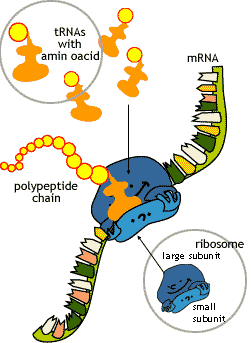 |
TranslationTranslation is the final step on the way from DNA to protein. It is the synthesis of proteins directed by a mRNA template. The information contained in the nucleotide sequence of the mRNA is read as three letter words (triplets), called codons. Each word stands for one amino acid. During translation amino acids are linked together to form a polypeptide chain which will later be folded into a protein. The translation is dependent on many components, of which two are extra important. First of all; the ribosome which is the cellular factory responsible for the protein synthesis. It consists of two different subunits, one small and one large and is built up from rRNA and proteins. Inside the ribosome the amino acids are linked together into a chain through multiple biochemical reactions. The second component is the tRNA, a specialised RNA molecule that carries an amino acid at one end and has a triplet of nucleotides, an anticodon, at the other end. The anticodon of a tRNA molecule can basepair, i.e form chemical bonds, with the mRNA's three letter codon.Thus the tRNA acts as the translator between mRNA and protein by bringing the specific amino acid coded for by the mRNA codon.
|